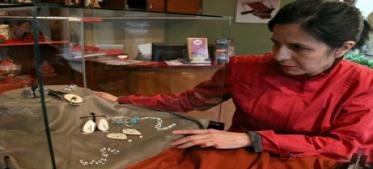Writing for the German magazine Der Spiegel (www.spiegel.de) in 2009, travel writer and art critic Otto Kirchner extolled the richness of Cuenca's tradition of arts and crafts. "Whether its ceramics, leather goods, jewelry, tapestry, painting or sculpture, the quality and variety of the work is exceptional. I found it to be every bit as good as that of Cuenca's sister city, Cusco."
In town to review the city's art biennal, one of South America's largest art exhibitions and juried competitions, Kirchner found himself captivated by the crafts vendors set up along the Tomebamba River as part of local holiday festivities. "One of my great pleasures, wherever I travel, is checking out local crafts fairs. It reveals a lot about a place and I liked what I saw in Cuenca."
Based on archeological records, Cuenca's crafts tradition dates back more than two thousand years, beginning with ceramics and weavings. About 1,000 years ago, the area's Cañari inhabitants began to fashion necklaces, pendants and masks from the gold and silver found in local rivers and streams.
The modern crafts tradition began with the Spanish in the early 16th century when Ecuador became the arts center of Latin America. Spanish priests and missionaries trained native artisans in religious painting, sculpture and ceramics and, although early works were mostly European recreations, the Spanish soon recognized the artistry of the indigenous imagination and this became widely incorporated into Ecuadorian works by the beginning of 17th century.
Of all its crafts, including the famous toquilla straw hats, Cuenca may be most famous for its ceramics. The Spanish introduced European designs and techniques that were eagerly adopted by local potters. In the 19th and 20th centuries, Cuenca became known as a center for the production of hand-crafted dinnerware. The tradition continues today at Artesa, a locally owned manufacturer that sells its products throughout Ecuador and exports to the U.S. and Europe.
Cuenca's Eduardo Segovia and Eduardo Vega, Ecuador's foremost living ceramicists, have established international reputations in the craft. Segovia's work, whimsically borrowing from traditions as far-ranging as the Italian Renaissance and the Aztecs, has exhibited widely and has received particular attention in Europe. Vega, who has a studio and showroom in Turi, south of Cuenca, is known for several large public installations in Quito and Cuenca.
The towns and villages surrounding Cuenca also provide a mother lode of exceptional crafts, many having developed artistic specialties. You'll find ikat fabric and leather goods in Gualaceo; silver and gold filigree jewelry in Chordeleg; and ceramics, baskets and musical instruments in Sigsig and San Bartolomé.
"When you visit Cuenca, by all means, buy a Panama hat," says Der Spiegel's Kirchner. "A good one is a work of art. On the other hand, don't ignore the city's other creations. If you do, you’ll be missing a lot."
Where to find that perfect gift
The famous indigenous outdoor market in the town of Otavalo, a two-hour drive north of Quito, is one of the best places to buy Andean art, crafts, textiles and indigenous jewelry in Ecuador. But if you're visiting Ecuador and your trip is limited to Cuenca and environs, you'll find plenty of places to partake in retail therapy, souvenir hunting, and gift shopping.
For starters, if you do not have your iconic Panama Hat, visit the Homero Ortega company on Avenida Gil Ramirez Dávalos, behind the main bus station. Homero Ortega exports hats to 32 countries on five continents. Five generations of the Ortega family have been dedicated to hat-making.In 2008, Homero Ortega opened its La Magia del Sombrero (Magic of the Hat) museum. The attractive three-room museum has bilingual exhibits on the history of the Panama hat, the hat-making process, and the history of Homero Ortega itself.
And another must visit center is the Esquina de las Artes located on the corner of 12 de Abril and Agustin Cueva. Opened in 2009,La Esquina de las Artes is a cultural, artistic, and commercial center for the exposition of art and artisan craftwork that. Built around a remodeled house, La Esquina creatively interconnects shops and restaurants and allows space for cultural and artistic presentations. La Esquina is also home to the Festival of Arts Expo held every November and April where specially invited artisans display and sell their work, such as well-known jewelry artist Silvia Loor.
Next, for a market atmosphere full of every imaginable kind of craft, visit the Centro Municipal Artesanal or CEMUART for short (also known as Casa de la Mujer). This municipal coop for artisans was launched in 1998 in order to preserve and support traditional Ecuadorean crafts; its slogan is "Hands that Work."
CEMUART is located on the west side of San Francisco Plaza, at General Torres 7-33 just south of Presidente Cordova. It's situated around two courtyards on two levels with more than 100 stalls manned by local craftspeople, selling textiles, leather, pottery, jewelry, ceramics, straw baskets and hats, tagua carvings, wood carvings, needlework, wrought-iron, and much more.
Plaza Rotary is another outdoor market for handicrafts and everyday household items located at Gaspar Sangurima and Vargas Machuca. Here you'll find everything from wooden spoons to major furniture, gardening tools to brass bells, hand-tied rope to tin plates, vases to mattresses. This whole area is chock-a-block with street vendors, produce purveyors, shops of every sort, and the big 9 de Octubre indoor market at Mariscal Lamar and Hermano Miguel.
The gift shop at the Museo de las Culturas Aborigenes on Calle Larga between Hermano Miguel and Mariano Cueva sells similar arts, crafts, and souvenirs, with a specialty in silver jewelry. If it's closed when you're visiting the museum, ask that it be opened; it is definitely worth a good, long look.
Finally, if you're hankering for Otavalan products, particularly textile goods, you'll find an excellent selection on the north side of San Francisco Plaza, catacorner to CEMUART. The sellers are Otavalans, most of them dressed in traditional attire.
Ciudad Cuenca
